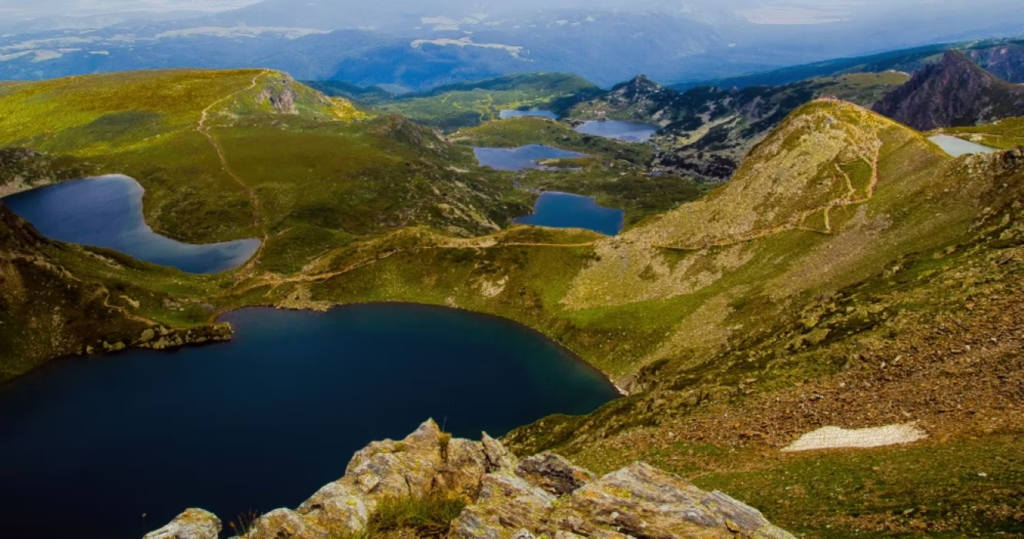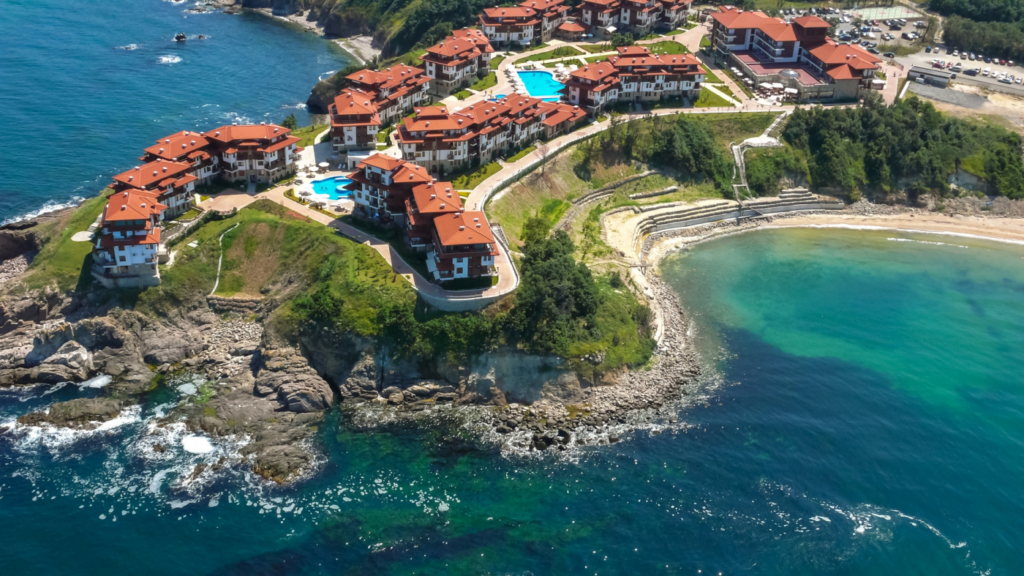Situated in the heart of the Balkan Peninsula, Bulgaria is a country of diverse landscapes, rich history, and vibrant culture. From its ancient cities and medieval fortresses to its stunning mountains and beautiful beaches, Bulgaria offers a plethora of attractions for travelers seeking a unique and immersive experience.
Table of Contents
Geography
Bulgaria is located in southeastern Europe, bordered by Romania to the north, Serbia and North Macedonia to the west, Greece and Turkey to the south, and the Black Sea to the east. The country spans approximately 110,994 square kilometers, featuring a varied topography that includes the Danubian Plain in the north, the Balkan Mountains running through the center, and the Thracian Plain in the south. The Black Sea coastline stretches for about 378 kilometers, offering picturesque beaches and resorts.
States of Bulgaria
Bulgaria is not divided into states but is organized into 28 administrative regions known as “oblasts.” Each oblast has its own local government and administrative structure. Here’s a comprehensive table showing all 28 oblasts of Bulgaria along with all the cities included in each:
| No. | Oblast | Cities Included |
|---|---|---|
| 1 | Sofia City | Sofia |
| 2 | Plovdiv | Plovdiv, Asenovgrad, Karlovo, Rakitovo, Sadovo, Sopot, Krichim, Perushtitsa, and Maritsa |
| 3 | Varna | Varna, Dobrich, Avren, Aksakovo, and Devnya |
| 4 | Burgas | Burgas, Sozopol, Nesebar, Sredets, and Pomorie |
| 5 | Ruse | Ruse, Ivanovo, Slivo Pole, and Borovo |
| 6 | Stara Zagora | Stara Zagora, Kazanlak, Pavel Banya, and Chirpan |
| 7 | Gabrovo | Gabrovo, Sevlievo, Dryanovo, and Veliko Tarnovo |
| 8 | Blagoevgrad | Blagoevgrad, Gotse Delchev, Razlog, Bansko, and Sandanski |
| 9 | Veliko Tarnovo | Veliko Tarnovo, Gorna Oryahovitsa, Lyaskovets, and Elena |
| 10 | Sliven | Sliven, Kotel, Nova Zagora, and Tvarditsa |
| 11 | Shumen | Shumen, Veliki Preslav, Novi Pazar, and Kaspichan |
| 12 | Lovech | Lovech, Troyan, Letnitsa, and Ugarchin |
| 13 | Yambol | Yambol, Elhovo, Straldzha, and Tarno Ruse |
| 14 | Targovishte | Targovishte, Opan, Bolyarovo, and Targovishte |
| 15 | Dobrich | Dobrich, Balchik, Kavarna, and General Toshevo |
| 16 | Montana | Montana, Berkovitsa, Chiprovtsi, and Boychinovtsi |
| 17 | Pleven | Pleven, Cherven Bryag, Svishtov, and Nikopol |
| 18 | Kyustendil | Kyustendil, Dupnitsa, Boboshevo, and Nevestino |
| 19 | Pernik | Pernik, Radomir, and Kyustendil |
| 20 | Haskovo | Haskovo, Dimitrovgrad, Svilengrad, and Harmanli |
| 21 | Razgrad | Razgrad, Kubrat, Isperih, and Vetovo |
| 22 | Silistra | Silistra, Tutrakan, Dve Mogili, and Zavet |
| 23 | Vidin | Vidin, Belogradchik, Kula, and Dimovo |
| 24 | Sofia | Sofia |
| 25 | Svilengrad | Svilengrad, Maritsa, and Hristo Danov |
| 26 | Karlovo | Karlovo, Sopot, and Klisura |
| 27 | Smolyan | Smolyan, Chepelare, Pamporovo, and Zlatograd |
| 28 | Dupnitsa | Dupnitsa, Bobov Dol, Krupnik, and Peshtera |
History
Bulgaria’s history is a rich tapestry woven through millennia, reflecting the legacies of numerous civilizations. The Thracians, known for their advanced society and magnificent tombs, laid the foundation of Bulgaria’s ancient history. The Thracian Tomb of Kazanlak and the Thracian Tomb of Sveshtari, both UNESCO World Heritage Sites, reveal the artistry and spiritual beliefs of this ancient culture.
Following the Thracians, Bulgaria became part of the vast Roman Empire. The Roman era left a significant mark on the country’s cultural and architectural landscape. Notable Roman ruins include the Ancient Theatre of Plovdiv, which still hosts performances today, and the Roman Baths of Varna, illustrating the grandeur of Roman engineering and social life.
The establishment of the First Bulgarian Empire in 681 AD marked the emergence of a powerful medieval state. Under the rule of Tsar Simeon the Great in the 10th century, Bulgaria experienced a cultural and territorial zenith, becoming a hub of Slavic culture and Orthodox Christianity. The capital, Preslav, became a center of learning and arts.
The Second Bulgarian Empire (1185-1396) saw a resurgence of Bulgarian power and culture, particularly under the reign of Tsar Ivan Asen II. The fortress of Tsarevets in Veliko Tarnovo, the capital of the Second Empire, stands as a testament to this golden age, with its imposing walls and the Patriarchal Cathedral.
The Ottoman conquest in the late 14th century led to five centuries of Ottoman rule, profoundly influencing Bulgarian society, culture, and architecture. Despite this period of subjugation, Bulgarian identity and Orthodox Christian faith persisted, often centered around monasteries such as the Rila Monastery.
The 19th century National Revival period was a time of cultural and political reawakening, culminating in the April Uprising of 1876 and the subsequent liberation of Bulgaria in 1878, following the Russo-Turkish War. This period saw the construction of numerous churches, schools, and cultural institutions, exemplified by the architectural style of Bulgarian Revival houses in towns like Koprivshtitsa and Tryavna.
Sofia: The Vibrant Capital
Sofia, the capital of Bulgaria, is a city that seamlessly blends the old with the new. Visitors can explore the Alexander Nevsky Cathedral, one of the largest Eastern Orthodox cathedrals in the world, and the medieval Boyana Church, a UNESCO World Heritage Site famous for its exquisite frescoes. Sofia’s Vitosha Boulevard offers a lively atmosphere with its cafes, shops, and restaurants, while the Vitosha Mountain provides a scenic backdrop and opportunities for hiking and skiing.
Top Ten Must-Visit Destinations in Bulgaria
Bulgaria is a treasure trove of historical sites, stunning landscapes, and vibrant culture. While cities like Sofia and Plovdiv are well-known, the country is home to remarkable destinations that offer unique experiences. Here’s a guide to the top ten must-visit places in Bulgaria.
1. Rila Monastery

The Rila Monastery, a UNESCO World Heritage Site, is Bulgaria’s most significant religious and cultural monument. Nestled in the picturesque Rila Mountains, it was founded in the 10th century by St. John of Rila. The monastery features stunning architecture, intricate frescoes, and a tranquil setting, making it a must-visit for anyone interested in Bulgarian history and spirituality. The peaceful atmosphere and beautiful surroundings provide a perfect backdrop for reflection.
2. Seven Rila Lakes

The Seven Rila Lakes are a group of glacial lakes situated in the Rila Mountains, renowned for their breathtaking beauty. Each lake is named after its distinctive shape or characteristics, such as the Tear, the Eye, and the Kidney. The lakes are popular among hikers, offering various trails that lead to stunning viewpoints. The area is also a great spot for picnicking and enjoying the tranquility of nature.
3. Nessebar

Nessebar, a UNESCO World Heritage Site, is a historic town located on a small peninsula along the Black Sea coast. Known for its well-preserved medieval architecture, the town features ancient churches, cobblestone streets, and charming houses. Key highlights include the Church of St. Sophia and the Church of Christ Pantocrator. Nessebar’s picturesque setting, combined with its rich history, makes it a captivating destination for visitors.
4. Belogradchik Rocks

The Belogradchik Rocks are a stunning natural wonder located in northwest Bulgaria. These unique rock formations, some reaching heights of up to 200 meters, have been shaped by erosion over millions of years. The area is home to the Belogradchik Fortress, which dates back to Roman times and offers panoramic views of the surrounding landscape. Hiking trails in the region provide opportunities for exploration and breathtaking scenery.
5. Thracian Tomb of Kazanlak

The Thracian Tomb of Kazanlak is another UNESCO World Heritage Site, famous for its beautifully preserved frescoes dating back to the 4th century BC. The tomb is part of the Kazanlak Valley, known as the Valley of the Thracian Kings. The intricate murals depict scenes of the Thracian funeral rite and provide valuable insights into ancient Thracian culture. The site is an essential visit for those interested in archaeology and history.
6. Pirin National Park

Pirin National Park, a UNESCO World Heritage Site, is renowned for its stunning landscapes, diverse wildlife, and rich biodiversity. The park features the rugged peaks of the Pirin Mountains, alpine lakes, and ancient forests. Visitors can enjoy hiking trails that range from easy walks to challenging climbs, such as the ascent to Vihren Peak, the second highest peak in Bulgaria. The park is a haven for outdoor enthusiasts and nature lovers.
7. The Rock-hewn Churches of Ivanovo

The Rock-hewn Churches of Ivanovo, a UNESCO World Heritage Site, are a remarkable complex of medieval churches and monasteries carved into the rocks near the town of Ivanovo. Dating back to the 12th century, the churches are adorned with well-preserved frescoes that showcase the artistic style of the time. The site offers a unique glimpse into Bulgaria’s medieval spiritual life and is surrounded by beautiful nature.
8. Buzludzha Monument

The Buzludzha Monument, an iconic symbol of Bulgaria’s communist past, is a unique architectural structure located on Buzludzha Peak. Built in the 1980s, the monument resembles a UFO and was designed to commemorate the founding of the Bulgarian Socialist Party. Though it is now abandoned, the structure’s intriguing design and panoramic views of the surrounding mountains make it an interesting destination for those curious about Bulgaria’s history.
9. Sozopol

Sozopol is a charming seaside town located on the Black Sea coast, known for its rich history and beautiful beaches. Founded in the 6th century BC, Sozopol is one of Bulgaria’s oldest towns and features a mix of ancient ruins and traditional wooden houses. The town hosts various cultural events, including the Apollonia Arts Festival, celebrating art, music, and theater. Sozopol’s picturesque setting and vibrant atmosphere make it a perfect destination for relaxation and exploration.
10. Koprivshtitsa

Koprivshtitsa is a small historic town known for its well-preserved Bulgarian National Revival architecture. The town played a significant role in the Bulgarian National Revival period and is home to several museums dedicated to notable figures from Bulgarian history. Visitors can stroll through the colorful streets, admire the traditional houses, and learn about the town’s rich cultural heritage. Koprivshtitsa is an ideal destination for those interested in history and architecture.
Cultural Riches
Bulgaria’s cultural heritage is deeply rooted in its traditions, folklore, and music. The Rose Valley, near the town of Kazanlak, is famous for its rose oil production and the annual Rose Festival, celebrating the country’s connection to this fragrant flower. Bulgarian folk music, characterized by its complex rhythms and harmonies, is an essential part of the nation’s cultural identity. Traditional dances like the horo are performed at festivals and celebrations, showcasing the vibrant spirit of the Bulgarian people.
Natural Beauty
Bulgaria is blessed with diverse natural landscapes, from majestic mountains to serene beaches. The Rila Mountains, home to the highest peak in the Balkans, Musala, offer excellent hiking and skiing opportunities. The Pirin and Rhodope Mountains are also popular for their stunning scenery and outdoor activities. The Seven Rila Lakes, a group of glacial lakes situated in the Rila Mountains, are a breathtaking natural wonder and a popular hiking destination.
The Black Sea coast boasts beautiful beaches and charming seaside towns. Sunny Beach and Golden Sands are well-known resort areas offering a lively atmosphere and various water sports. For a more tranquil experience, the historic town of Sozopol and the picturesque Nessebar, a UNESCO World Heritage Site, provide a glimpse into Bulgaria’s maritime heritage.
Cuisine and Wine
Bulgarian cuisine is a delightful blend of flavors and influences, featuring fresh vegetables, herbs, and spices. Traditional dishes such as banitsa (a pastry filled with cheese), kavarma (a meat and vegetable stew), and tarator (a cold cucumber and yogurt soup) are must-tries. Bulgaria is also renowned for its dairy products, particularly yogurt and sirene cheese, which play a central role in the country’s culinary tradition.
The country’s wine-making tradition dates back to Thracian times, and Bulgaria is known for producing high-quality wines. The Thracian Valley and the Danubian Plain are the main wine-producing regions, offering a variety of red and white wines. Notable grape varieties include Mavrud, Melnik, and Rubin.
Top Eight Most Famous Food of Bulgaria








Festivals and Celebrations
Bulgaria’s calendar is filled with vibrant festivals and celebrations that reflect its rich cultural heritage. The Kukeri Festival, held in various towns and villages, features elaborately costumed dancers performing rituals to ward off evil spirits and ensure a bountiful harvest. The Surva International Festival of Masquerade Games in Pernik is another spectacular event showcasing traditional masquerade rituals and folklore.
In March, Bulgarians celebrate Baba Marta by exchanging red and white woven bracelets called martenitsi, symbolizing health and prosperity. The Rose Festival in Kazanlak, held in June, is a colorful celebration of the rose harvest, featuring parades, music, and dance.
Architectural Wonders
Bulgaria boasts a wealth of architectural marvels spanning various historical periods. The Rila Monastery, founded in the 10th century, is a masterpiece of Bulgarian National Revival architecture, with its richly decorated church, frescoes, and stunning mountain setting. The Bachkovo Monastery, near Plovdiv, is another significant religious site, known for its beautiful frescoes and tranquil atmosphere.
The Alexander Nevsky Cathedral in Sofia, with its impressive gold-domed structure, is a symbol of Bulgaria’s Orthodox Christian heritage. The medieval churches of Nessebar, including the Church of Christ Pantocrator and the Church of St. John Aliturgetos, are notable examples of Byzantine architecture.
Outdoor Activities
Bulgaria’s diverse landscapes provide ample opportunities for outdoor enthusiasts. The country’s numerous national parks, such as Rila, Pirin, and Central Balkan, offer excellent hiking, climbing, and wildlife-watching experiences. The Rhodope Mountains are also popular for their scenic trails and traditional villages.
In winter, Bulgaria’s ski resorts, such as Bansko, Borovets, and Pamporovo, attract skiers and snowboarders with their well-maintained slopes and modern facilities. The country’s extensive cave systems, including the Magura Cave and the Devil’s Throat Cave, offer exciting spelunking adventures.
Conclusion
Bulgaria is a country of captivating contrasts, where ancient history meets modern culture, and natural beauty abounds. Whether exploring its historical sites, enjoying its vibrant festivals, or simply soaking in its stunning landscapes, visitors to Bulgaria will find a land rich in experiences and memories. With its warm hospitality, delicious cuisine, and rich traditions, Bulgaria offers an unforgettable journey through a land where the past and present coexist in perfect harmony.

